CATHEDRAL QUEST
Our quest to experience the great cathedrals and churches of Europe
FRANCE 2012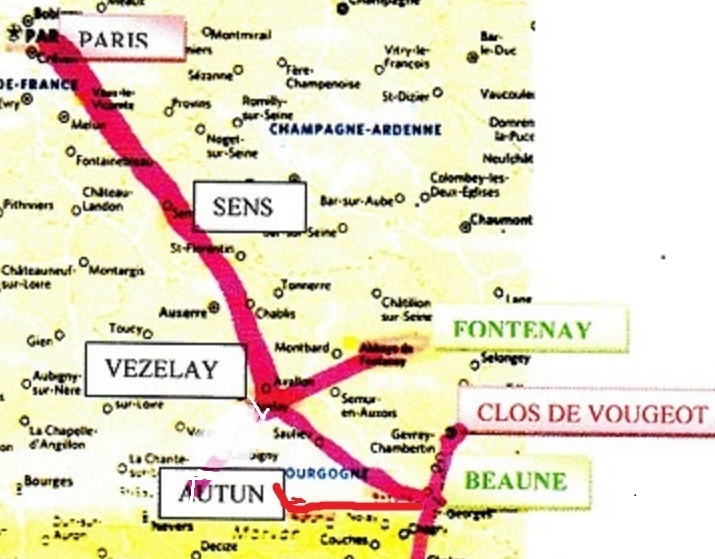
DAY 5, FRIDAY, SEPT.7
VEZELAY TO
BEAUNE
We ate breakfast again in hotel breakfast room – same menu as yesterday,
only my wife didn’t try to hard boil an egg. Then we packed up and
checked out and started for Beaune. We were on about half of the A6
toll-road that we were on yesterday going to Abbaye Fontenay. Again we
paid correctly and went through the tollgate without difficulty. I
forgot to mention that the road from A 6 to Vezelay was like driving on
W.Va. mountain roads– 2 lanes, very curvy and up and down hill. Our car
is a manual 5 speed – diesel. My right arm and left foot got a lot of
exercise… it was 13 miles which we did for a total of coming and going
twice.
It took about an hour and a half to reach Beaune. It is a beautiful old
town and quite active compared to Vezelay. The population of Beaune is
22,012 compared to Vezelay with 478.
Beaune lies at the heart of Burgundian vineyards. The town was
first a center under the Gauls, and then an outpost of Rome. Beaune was
the seat of the Dukes of Burgundy to the 14th century. After the death
of Charles the Bald, last Duke of Burgundy, in 1477, the town refused
Louis XI's efforts to annex it and gave in only after a five week siege.
The relatively well-preserved ramparts form an almost continuous wall
walk. We will see some of them tomorrow. They were built between the end
of the 15th century in the middle of the 16th century and are adorned
with a few surviving towers and eight rustic bastions of various shapes.
The double bastion, originally a Castle, is known as the Bastion St.
Jean. The encircling
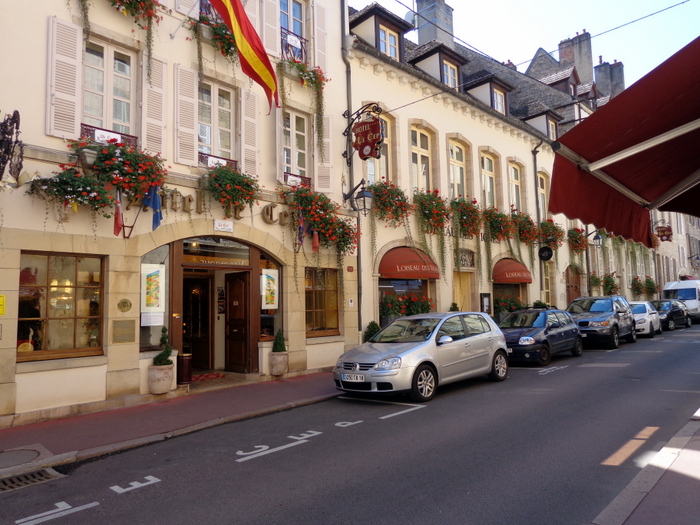 moat is now occupied by gardens, tennis courts etc.
moat is now occupied by gardens, tennis courts etc.
Our GPS got us right to the hotel Le Cep. It is a beautiful first class
old hotel on a very narrow street. They took our car somewhere to park
it. Our room is large and very
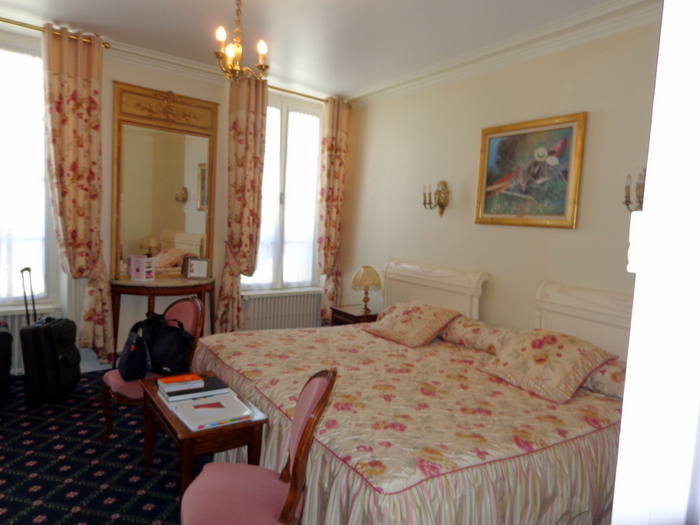 beautifully appointed.
beautifully appointed.
After we checked in, it was time to have lunch. The desk clerk
recommended a nice bistro around the corner. We both had salmon with a
sauce and noodles. It was delicious. We were only a block from the
Beaune Hospice (Hotel Dieu) which is one of the reasons for coming
here. I had made a MODEL of it.
BEAUNE HOSPICE (HOTEL DIEU)
The end of the hundred year war in Beaune did not bring about a
hoped-for prosperity.
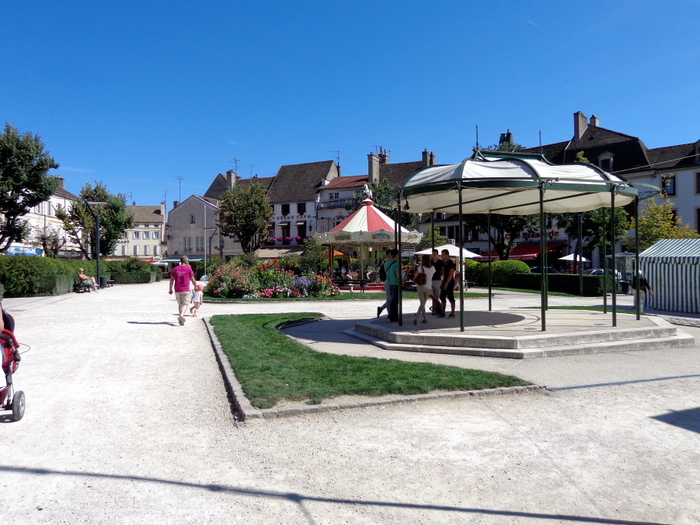 Unfortunately, vast poverty follow this conflict,
which stretched over a century. All the cities and villages suffered
from famine, while the poor and starving, who had no place to go,
perished in squalor. Finally, the plague appeared, adding to a long list
of devastation. Pleas and outcries from all over the country were sent
to those in power, begging for assistance .Nicolas Rolin and his wife,
Guigone de Salins were moved to act. In 1441, the Chancellor asked for
the Popes' support to create a hospice in Beaune or in Autun. Finally in
1443, the deed of foundation was pronounced, and Beaune was chosen in as
the site because it suffered more from the miseries.
Unfortunately, vast poverty follow this conflict,
which stretched over a century. All the cities and villages suffered
from famine, while the poor and starving, who had no place to go,
perished in squalor. Finally, the plague appeared, adding to a long list
of devastation. Pleas and outcries from all over the country were sent
to those in power, begging for assistance .Nicolas Rolin and his wife,
Guigone de Salins were moved to act. In 1441, the Chancellor asked for
the Popes' support to create a hospice in Beaune or in Autun. Finally in
1443, the deed of foundation was pronounced, and Beaune was chosen in as
the site because it suffered more from the miseries.
The best Flemish artist were chosen for the design. Every
 detail
was planned to make this foundation a true palace, the "palace for the
poor" with no expenses spared. The overall hospice was designed as a
vast rectangle. The exterior was extremely austere and appears as the
highest building of the area built with expensive material like slate
and stone. On the interior all the rooms were laid out around a large
sunny courtyard.
detail
was planned to make this foundation a true palace, the "palace for the
poor" with no expenses spared. The overall hospice was designed as a
vast rectangle. The exterior was extremely austere and appears as the
highest building of the area built with expensive material like slate
and stone. On the interior all the rooms were laid out around a large
sunny courtyard.
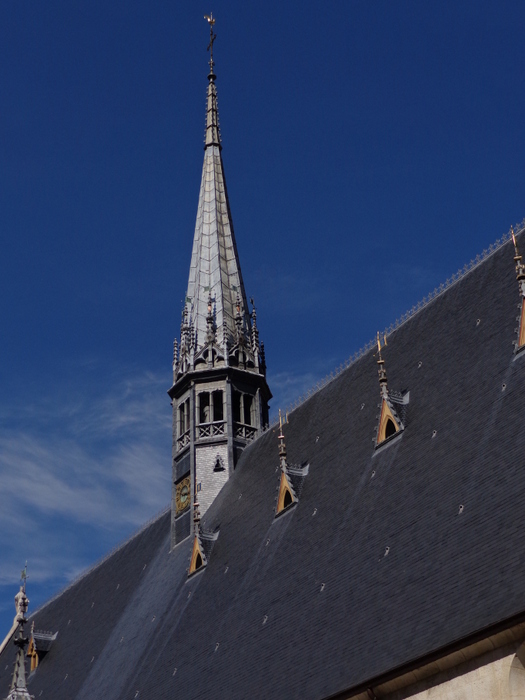 It took eight years to complete the project. This intense activity and
lavish design stimulated the regional economy, creating prosperity
throughout the entire region of Beaune and beyond.
It took eight years to complete the project. This intense activity and
lavish design stimulated the regional economy, creating prosperity
throughout the entire region of Beaune and beyond.
Today, from the exterior, the building looks rather plain, with its tall
and steeply pitched slate roof and dormer windows, the weathervanes, the
delicate pinnacles, and lace work cresting of lead. The roof line is
broken by the bell tower topped by a slim Gothic spear 98 feet high.
The delicate roof above the porch is composed of three slate gables
terminating in pinnacl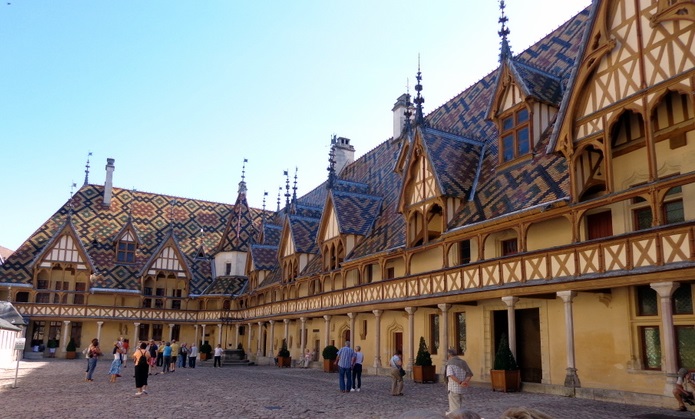 es. Each weathervane bears a different coat of
arms.
es. Each weathervane bears a different coat of
arms.
Entering the courtyard, we saw the building roofs. These famous,
beautiful roofs are punctuated by turrets and a double row of dormer
windows, topped by weathervane's adorned with heraldic bearings and
small spires. The roofs are of colored glazed tile in geometric
patterns.
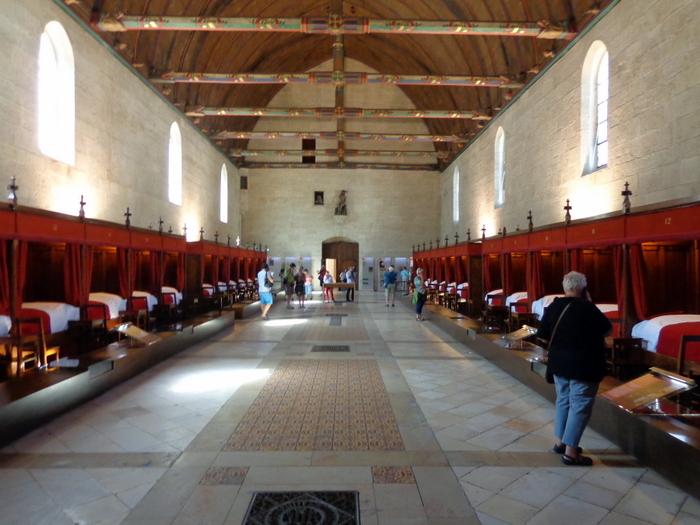
In the interior of the immense hall- the Grand Salle, measuring 236 feet
long and 46 feet wide was used as the poor ward.
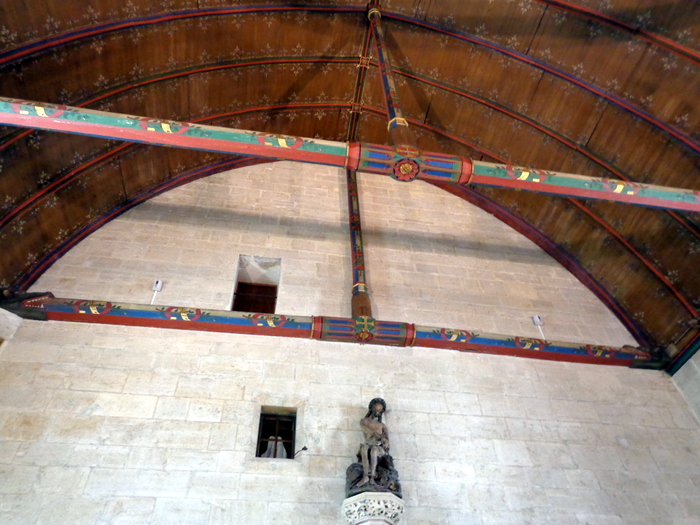
It has a magnificent
timber roof in the shape of an upturned keel and is painted throughout.
The end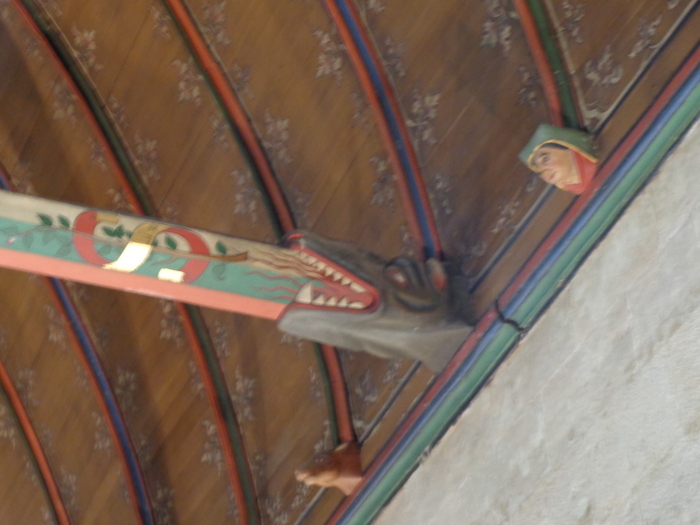 s of the tie beams disappear into the gaping mouths of monster
heads.
s of the tie beams disappear into the gaping mouths of monster
heads.
\
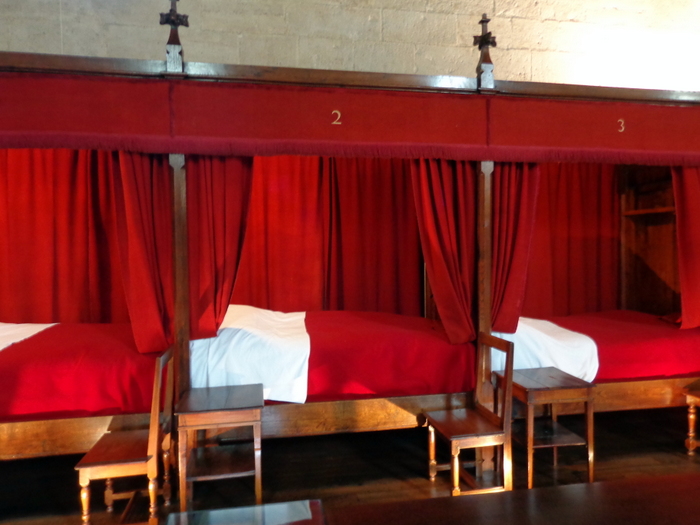
There is a double row of beds, each bed in its own compartment
with red and white bedclothes. Each bed has red draperies which can be
closed for privacy. Outside of the drapes are a small table and a
chair. My model has part of the roof cut out so the rows of beds can be
seen.
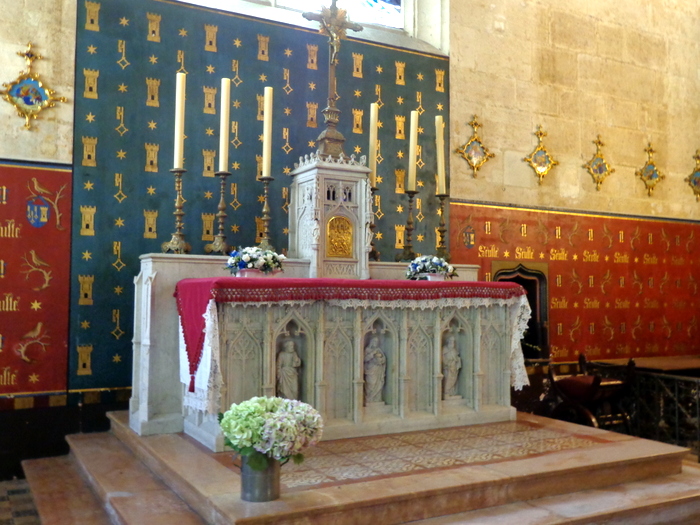
At one end of the room stands a large life-size polychrome wooden statue
of Christ seated and bound, which was carved from a single piece of oak.
At the opposite end is a Flamboyant style screen separating the Grand
Salle from the chapel which was reconstructed in the 19th century. Over
the altar and is large stained-glass window.
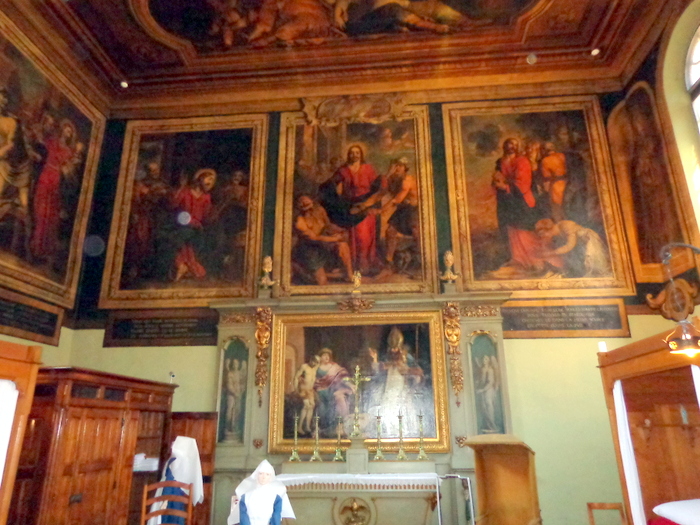
Leaving the chapel, we entered a small room with 12 beds and a number of
beautiful paintings over the altar. Around the corner was a large room
which had a model of the building plus exhibits of medical instruments
and history of the building.
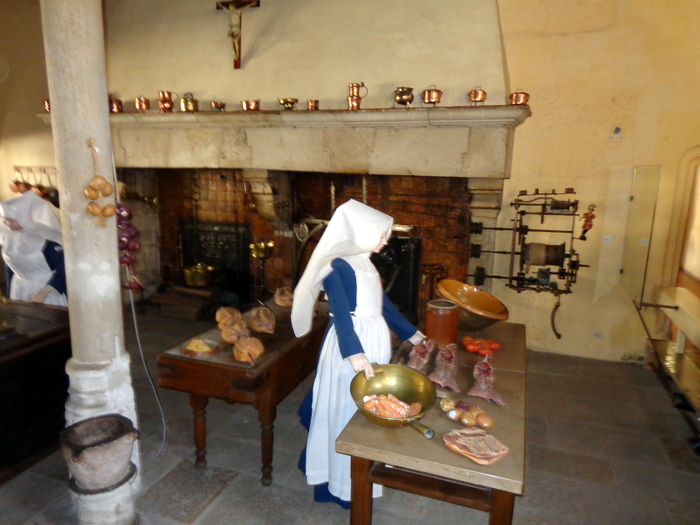 The next stop was kitchen which was set up as an old fashion scene
around a huge Gothic fireplace with his double hearth and automatic
spit. There were manikins dressed in the habit of the nuns, situated as
if preparing a meal.
The next stop was kitchen which was set up as an old fashion scene
around a huge Gothic fireplace with his double hearth and automatic
spit. There were manikins dressed in the habit of the nuns, situated as
if preparing a meal.
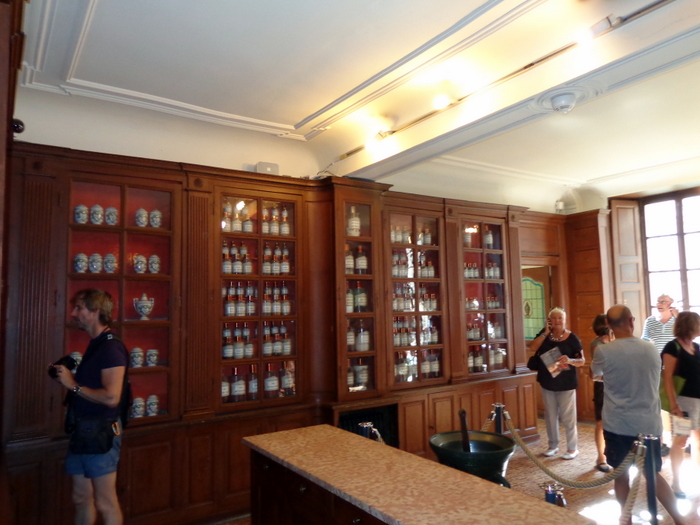
The next room was the pharmacy. The walls were
lined with shelves holding jars of medicine and herbs.
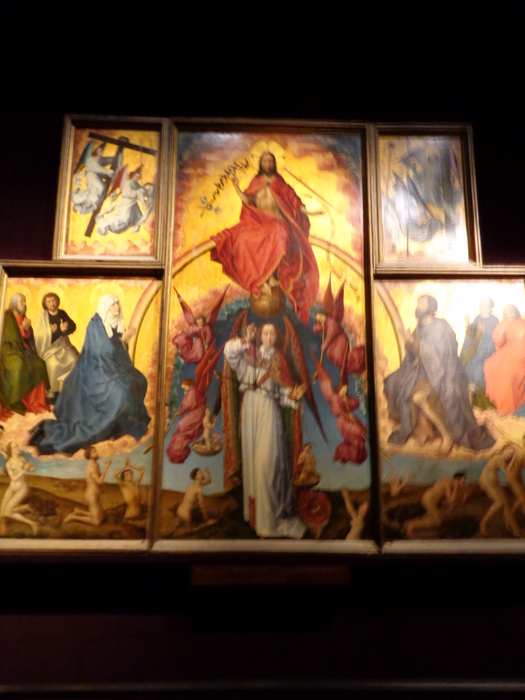 There was another building in the courtyard which contained a large room
which exhibited the famous polyptych of the Last Judgment by Rogier van
der Weyden. This large masterpiece of Flemish art, commissioned by
Nicolas Rolin, previously graced the altar in the Grand Salle. It was
completed between 1445 and 1448 and extensively restored in the 19th
century.
There was another building in the courtyard which contained a large room
which exhibited the famous polyptych of the Last Judgment by Rogier van
der Weyden. This large masterpiece of Flemish art, commissioned by
Nicolas Rolin, previously graced the altar in the Grand Salle. It was
completed between 1445 and 1448 and extensively restored in the 19th
century.
This was a very wonderful place to visit. It served as a general
hospital until 1971 when it became a museum for tourist.
SEE MY MODEL. We spent a long
time there, and then walked to the cathedral which is about 2 blocks
from our hotel.
NOTRE DAME CATHEDRAL - BEAUNE
The first Cathedral in Beaune was built in a swampy area in the eighth
century. It was dedicated to St.Baudele, a martyr born in Nîmes, whose
r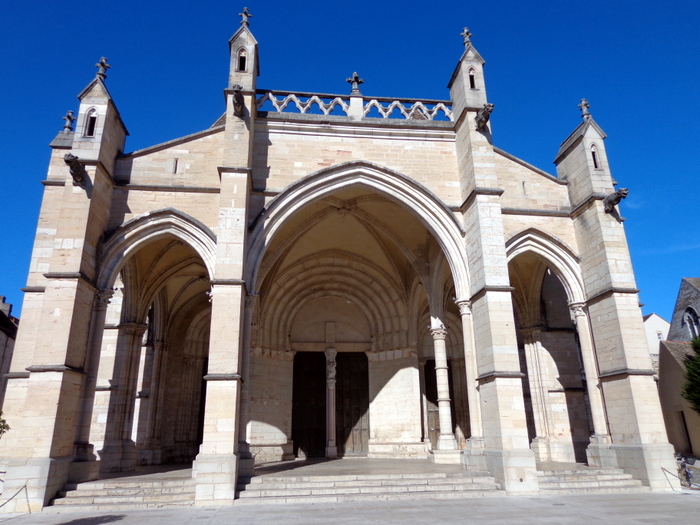 elics have been brought back by monks in order to prevent the Saracen's
attacks.
elics have been brought back by monks in order to prevent the Saracen's
attacks.
At the beginning of the 12th century, as the Crusades were being
launched, the church had become too small so the knights going to
Jerusalem donated to the clergy to help build a new church.
In the present Cathedral was built in the 12th
 century by Etienne de
Bage, the Bishop of Autun, who build at the same time the Cathedral of
Autun. The Beaune Cathedral is one of the largest Romanesque buildings
of Burgundy, built on the model of the Abbey of Cluny.
century by Etienne de
Bage, the Bishop of Autun, who build at the same time the Cathedral of
Autun. The Beaune Cathedral is one of the largest Romanesque buildings
of Burgundy, built on the model of the Abbey of Cluny.
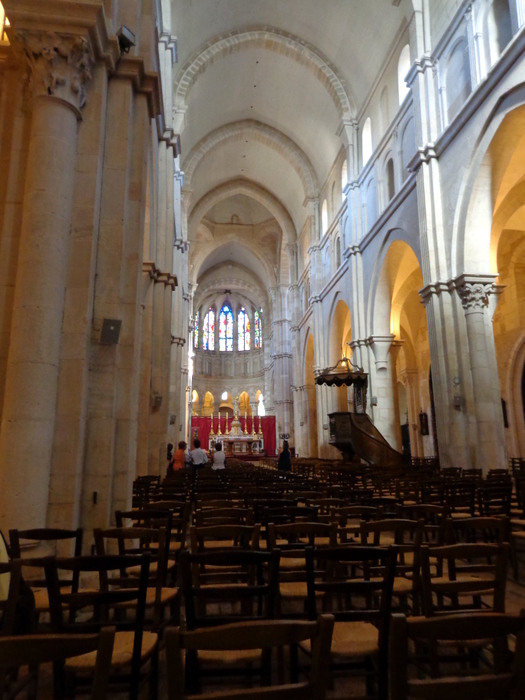
The nave has six
bays and an extended transept, a choir with an ambulatory and three
radiating chapels. The 13th and 14th centuries altered the building with
some Gothic structures – the upper parts of the apse and the bell tower.
The nave is supported by flying buttresses, two towers stand on the
front and an open porch built in the 12th century.
The steeple
surmounting the crossing of the nave and
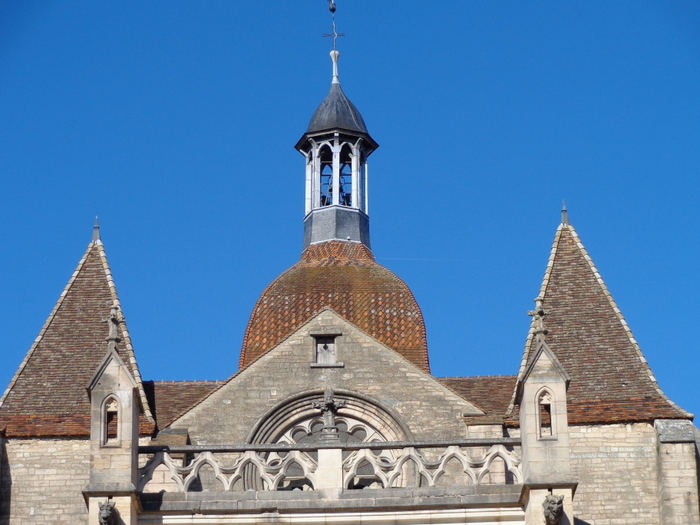 transept, was built in several
stages. The first floor built in the 12th century, consisted of blind
arches and fluted pilasters. The upper floor of the 13th century had
three lancet windows between two blind arches on each side. The dome
lantern of the Renaissance style, dates from the 1580s. There were a
number of interesting tapestries as well as beautiful stained-glass
windows in the apse.
transept, was built in several
stages. The first floor built in the 12th century, consisted of blind
arches and fluted pilasters. The upper floor of the 13th century had
three lancet windows between two blind arches on each side. The dome
lantern of the Renaissance style, dates from the 1580s. There were a
number of interesting tapestries as well as beautiful stained-glass
windows in the apse.
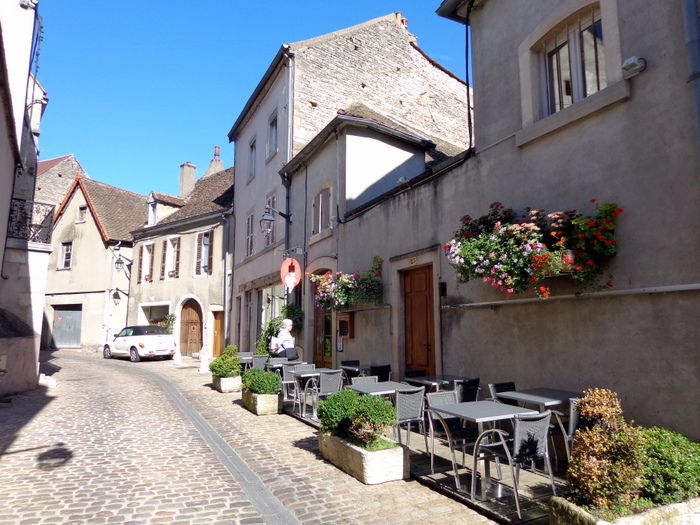
We went back to the hotel and had our complimentary drinks in the
hotel’s courtyard. We rested a little while and walked back towards the
Hospice to the Petit Paradise restaurant, where my wife had made
reservations months ago. It was small, and locally owned. We had a
wonderful dinner. I had a small steak with a cheese sauce and she had a
leg of lamb. I had a dessert that tasted like toffee pudding and my
wife had a plate of 4 kinds of cheese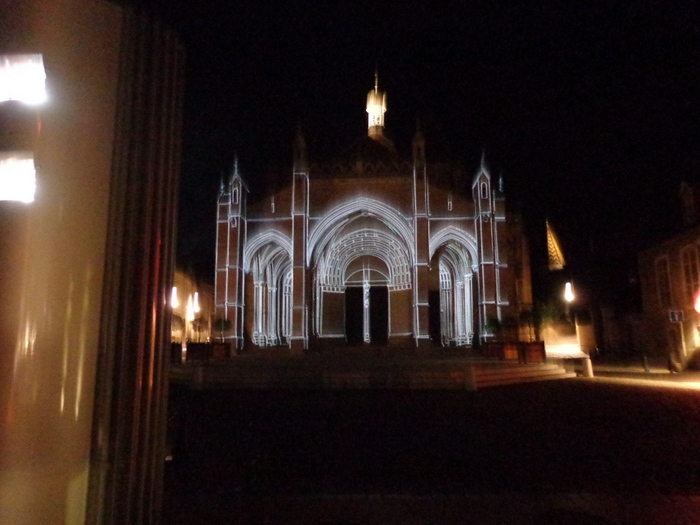 ----some of it was pretty smelly.
She had been complaining that she’s been in France several times, but
never had a “cheese course”.
----some of it was pretty smelly.
She had been complaining that she’s been in France several times, but
never had a “cheese course”.
As walked back, we were told about several buildings that had light
shows. We saw two of them –one on the cathedral. We were really full
…to full to go to bed…and very sleepy.
 It took eight years to complete the project. This intense activity and
lavish design stimulated the regional economy, creating prosperity
throughout the entire region of Beaune and beyond.
It took eight years to complete the project. This intense activity and
lavish design stimulated the regional economy, creating prosperity
throughout the entire region of Beaune and beyond.
